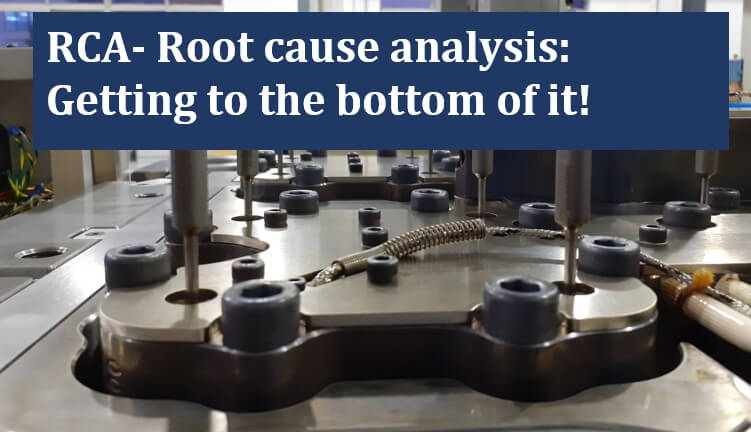Appearances can be deceptive. Especially when a failure can be the result of several factors that act either in isolation or in combination. Precisely why Root Cause Analysis or RCA adopts a nuanced, diligent approach to get to the very bottom of things.

Root Cause Analysis is rarely a skill mentioned in a job description. However, to be fair, every manager does conduct an RCA on a routine basis to be able to make informed decisions. Every deal needs background research akin to RCA. Reading case studies and methodologies for RCA are only as good as theoretical guidance for actual application. RCA is largely about good observations, good understanding of the basics of statistics, and an unyielding ability to stick to what one knows without making assumptions or jumping to conclusions. RCAs are often tedious as there is a huge list of possibilities, and multiple lines of apparently rational explanations leading to the same issue at hand. Most of the plausible explanations are either non-ratifiable or a dead end to experimentation due to unreasonable approach or higher cost.
RCA often resembles a project with constraints of cost, time, and risk of wrong decisions. RCA is usually expected to correct an underlying cause, which could be only discoverable with time. Sometimes, RCAs are linked to allocation of penalties and can be very tricky to detangle i.e. correlate the cause and effect without confusing one for the other. In this article I would like to share some nuances of RCA, an ice breaker with the blog readers. Based on the feedback and response to this article, we can share subsequent content that deep dives into the exact process of RCA, the creative process as well as the iterative and defined one.
The key components of an RCA are:
- Immediate findings and interim containment actions – evaluation of ICA;
- All possible and actual findings that contribute towards the failure – assessment and reasoning for all factors;
- Verification of root cause;
- Permanent corrective action; and
- Notes about the tests and validations conducted, confidence level, and percentage contribution of factors to the failure.
I. COMMON MISTAKES
People tend to think in certain ways that can lead to systematic deviations from rational judgment-making. The most common and infamous of all biases is the casual correlation bias. Every statistical piece of data can be analyzed for a correlation – if there is a regression found in that data, it is common human tendency to casually correlate the factors. While regression can be explained, it does not necessarily have a cause. This is the prime factor that I have found to be of monumental importance in correcting the affairs of a system or in concluding a statistical inference. We at EIPL, have over the past year conducted many RCA and data-based analysis, all culminating in correcting a common mistake – casual correlation of the dependent and independent factors involved in the analysis; where a rightly identified regression was mistaken for a cause.
Let me explain with an example from the injection moulding industry. Every time a component fails on the assembly line or the packaging line, we check for outliers in the component measurement results and the functional test results. Incidentally, higher leakages on the packaging line can occur alongside increased instances of lower lid removal forces in the lab. While the two factors seem perfectly correlated and logically compliant, they cannot be causally correlated. For the regression to be one of cause and effect, they must be separate enough to be tested in isolation or they must not violate the false negative tests.
II. KEY CHALLENGES

Missing Information: Because it is impossible to have all data and maintain / monitor it for a long time, the key data that is required for RCA may often be missing or difficult to obtain. Or impossible considering the chronology of events. Thus, the key skill boils down to the ability to detect causal relations based on available information. In technical RCA, the statistical point of view is often not considered or not known. There are approaches available, such as path analysis, hierarchical affinity study, and discounting values for outliers, significance values to be considered before we determine the weightage of the possible contributing factors.
Gathering Data & Evidence to Establish the Sequence of Events

This can be exhaustive as different OEMs and teams might need to brainstorm together to determine the possible pathways of collecting information. The key to getting this step lies in making detailed process mapping diagrams either in excel sheets or on paper with inputs from the people who best know the process.
Multiplicity of Root Causes & Viewpoint Layers: This is a very interesting point when it comes to root cause analysis. It is quite likely that different factors contribute to the situation or occurrence of the issue under investigation. However, another parallel contributor is the multiplicity of those factors happening together. Do they always happen together?
When saying that we have reached the root cause, it may be so from the point of view of that particular department. For example, the why- why analysis has led to the understanding that issues such as manufacturing tolerances could be a result of tolerances in the IM tool or the core insert, in addition to many other factors such as stack-up tolerances, assembly methods, workmanship, or maintenance practices. For the customer as well as the mould maker, these could be the “root cause”. If this root cause was shared with the technical head of the company, he / she may dive down deeper into why the manufacturing tolerances for individual components were not met, and discover that the electrodes used were worn out, the alignment method was faulty, the frequency of checks with the milling tool was insufficient, the tool selection was incorrect, or a combination of some of these factors.
With knowledge of the same root cause, the managing director of the company may investigate why the method was not right or why the selection of the tool was incorrect. The MD may discover that there was insufficient budget to maintain the cutters, the personnel were overworked, the tool was bought from the cheapest bidder, so on and so forth. Thus, who is asking for the RCA and with what intent becomes very important.
Solving a challenge requires finding its correct cause. Otherwise, corrective efforts are directionless and useless. Pointing the troubleshooters in the right direction is RCA. In the next article we will explore the creative side of forensic investigations, in IM industry. Until, then we wait to your hear your views and comments.

Efficient Innovations have worked on numerous RCA for our esteemed client’s on Plastic Moulds, Moulding process, Machines, Packaging automation and Filling line machines. We invite you to engage with us for further insights on how our team can assist you in conducting a comprehensive Root Cause Analysis for your prevailing issues. Your queries are important to us, and we are committed to providing the necessary guidance to help you navigate these challenges effectively.
BY RADHIKA SAWKAR

About the author: The author is a Senior Project manager at Efficient Innovations and has experience of conducting multiple valuable RCA assignments across the industry.





